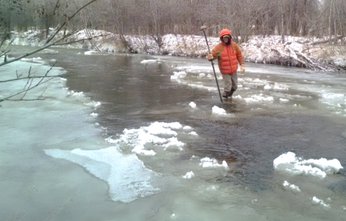Regulatory Compliance, Permitting
Clean Water Act (Sections 401 and 404)
National Environmental Policy Act (NEPA)
Endangered Species Act (ESA)
Wild and Scenic Rivers Act
Department of Environmental Quality
State game and fish departments
Local county planning and development regulations

For more than 35 years, Biota has utilized our extensive professional experience and multidisciplinary expertise to help clients navigate the multitude of federal, state, and local environmental regulations.
Clean Water Act
The regulatory branch of the US Army Corps of Engineers (USACE) administers and enforces Section 404 of the Clean Water Act. Under Section 404, a permit is required for the discharge of dredged or fill material into waters of the United States. Many water bodies and wetlands are considered waters of the United States and are subject to the Corps' regulatory authority. Biota staff is well versed in the latest jurisdictional guidance from the USACE; understands the complexity associated with jurisdiction determination; and can provide clients with a preliminary assessment of jurisdictional status of wetlands associated with their projects. Section 404 authorization can range from minor permits such as Nationwide, Programmatic and Regional General Permits to Individual Permits. If impacts exceed certain thresholds, compensatory mitigation is often required. Biota has obtained permits and developed mitigation plans for hundreds of projects in western Wyoming in the surrounding states.
Clean Water Act
The regulatory branch of the US Army Corps of Engineers (USACE) administers and enforces Section 404 of the Clean Water Act. Under Section 404, a permit is required for the discharge of dredged or fill material into waters of the United States. Many water bodies and wetlands are considered waters of the United States and are subject to the Corps' regulatory authority. Biota staff is well versed in the latest jurisdictional guidance from the USACE; understands the complexity associated with jurisdiction determination; and can provide clients with a preliminary assessment of jurisdictional status of wetlands associated with their projects. Section 404 authorization can range from minor permits such as Nationwide, Programmatic and Regional General Permits to Individual Permits. If impacts exceed certain thresholds, compensatory mitigation is often required. Biota has obtained permits and developed mitigation plans for hundreds of projects in western Wyoming in the surrounding states.

National Environmental Policy Act
The National Environmental Policy Act (NEPA) was signed into law on January 1, 1970. NEPA was established to “foster and promote the general welfare, to create and maintain conditions under which man and nature can exist in productive harmony, and fulfill the social, economic, and other requirements of present and future generations of Americans.” Through the NEPA process, agencies evaluate the environmental and related social and economic effects of their proposed actions. These actions include any project with a federal nexus, such as projects that occur on federally-administered lands or are funded by the federal government. NEPA requires federal agencies to incorporate environmental considerations in their planning and decision-making through a systematic interdisciplinary approach. Specifically, all federal agencies are to prepare detailed statements assessing the environmental impact of and alternatives to major federal actions significantly affecting the environment. This process results in one of three levels of NEPA analysis. Agencies may: 1.) apply a Categorical Exclusion (CE); 2.) prepare an Environmental Assessment (EA); or 3.) prepare an Environmental Impact Statement (EIS). Agencies also provide opportunities for public review and comment on those evaluations. Biota staff has years of experience working with and assisting federal agencies (e.g., National Park Service, Forest Service, Federal Highway Administration) in the NEPA analysis for a diverse array of projects.
The National Environmental Policy Act (NEPA) was signed into law on January 1, 1970. NEPA was established to “foster and promote the general welfare, to create and maintain conditions under which man and nature can exist in productive harmony, and fulfill the social, economic, and other requirements of present and future generations of Americans.” Through the NEPA process, agencies evaluate the environmental and related social and economic effects of their proposed actions. These actions include any project with a federal nexus, such as projects that occur on federally-administered lands or are funded by the federal government. NEPA requires federal agencies to incorporate environmental considerations in their planning and decision-making through a systematic interdisciplinary approach. Specifically, all federal agencies are to prepare detailed statements assessing the environmental impact of and alternatives to major federal actions significantly affecting the environment. This process results in one of three levels of NEPA analysis. Agencies may: 1.) apply a Categorical Exclusion (CE); 2.) prepare an Environmental Assessment (EA); or 3.) prepare an Environmental Impact Statement (EIS). Agencies also provide opportunities for public review and comment on those evaluations. Biota staff has years of experience working with and assisting federal agencies (e.g., National Park Service, Forest Service, Federal Highway Administration) in the NEPA analysis for a diverse array of projects.

Wild and Scenic Rivers Act
The Wild and Scenic Rivers Act was passed by Congress in 1968 to preserve and protect certain rivers with outstanding natural, cultural, and recreational values in a free-flowing condition for the enjoyment of present and future generations. While the Act provides a number of important measures to protect and enhance the values of designated Wild and Scenic Rivers, none is more significant than the restrictions on water resources projects provided in Section 7. Through the language of this section, Congress expressed the clear intent to protect river values from the harmful effects of water resources projects. Section 7 prohibits federal agencies from assisting in the construction of projects that would have a direct and adverse effect on a designated river or congressionally authorized study river. The Act also includes a standard that governs water resources projects below, above or on a stream tributary to a designated river or congressionally authorized study river. Biota’s offices in Jackson Hole are located in close proximity to a number of designated Wild and Scenic River reaches, and Biota has completed Wild and Scenic (Section 7) compliance documentation for a number of projects located within and upstream of designated Wild and Scenic watercourses.
The Wild and Scenic Rivers Act was passed by Congress in 1968 to preserve and protect certain rivers with outstanding natural, cultural, and recreational values in a free-flowing condition for the enjoyment of present and future generations. While the Act provides a number of important measures to protect and enhance the values of designated Wild and Scenic Rivers, none is more significant than the restrictions on water resources projects provided in Section 7. Through the language of this section, Congress expressed the clear intent to protect river values from the harmful effects of water resources projects. Section 7 prohibits federal agencies from assisting in the construction of projects that would have a direct and adverse effect on a designated river or congressionally authorized study river. The Act also includes a standard that governs water resources projects below, above or on a stream tributary to a designated river or congressionally authorized study river. Biota’s offices in Jackson Hole are located in close proximity to a number of designated Wild and Scenic River reaches, and Biota has completed Wild and Scenic (Section 7) compliance documentation for a number of projects located within and upstream of designated Wild and Scenic watercourses.

State Departments of Environmental Quality
Section 401 of the federal Clean Water Act requires state certification for any permit or license issued by a federal agency for an activity that may result in a discharge into waters of the U.S. This requirement allows each state to provide input in federally approved projects that may affect its waters (i.e., rivers, streams, lakes, and wetlands) and to ensure the projects will comply with state water quality standards and any other water quality requirements of state law. The state departments of environmental quality are typically responsible for issuing 401 certifications. Biota has a good professional working relationship with DEQ staff in the region and has a clear understanding of the 401 certification process in Wyoming and the surrounding states.
Section 401 of the federal Clean Water Act requires state certification for any permit or license issued by a federal agency for an activity that may result in a discharge into waters of the U.S. This requirement allows each state to provide input in federally approved projects that may affect its waters (i.e., rivers, streams, lakes, and wetlands) and to ensure the projects will comply with state water quality standards and any other water quality requirements of state law. The state departments of environmental quality are typically responsible for issuing 401 certifications. Biota has a good professional working relationship with DEQ staff in the region and has a clear understanding of the 401 certification process in Wyoming and the surrounding states.

Local/County Regulatory Compliance
Biota staff is well versed in local environmental regulations and we closely follow local government proceedings as they relate to natural resources and environmental regulations. We regularly complete Environmental Analyses (EAs), Zoning Compliance Verifications (ZCVs), habitat enhancement/mitigation plans, and grading and erosion control permit applications for projects in Teton County, Wyoming as required by the county's Land Development Regulations. We have also completed a number of Natural Resources Analyses (NRAs) and Wildlife Habitat Assessments to comply with local regulations in Teton County, Idaho.
Biota staff is well versed in local environmental regulations and we closely follow local government proceedings as they relate to natural resources and environmental regulations. We regularly complete Environmental Analyses (EAs), Zoning Compliance Verifications (ZCVs), habitat enhancement/mitigation plans, and grading and erosion control permit applications for projects in Teton County, Wyoming as required by the county's Land Development Regulations. We have also completed a number of Natural Resources Analyses (NRAs) and Wildlife Habitat Assessments to comply with local regulations in Teton County, Idaho.
